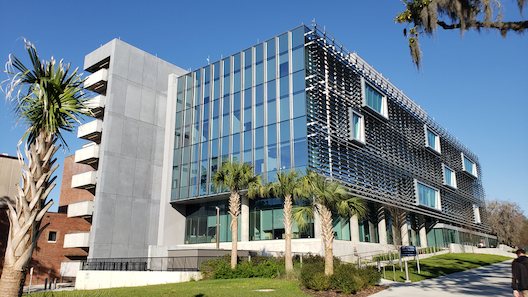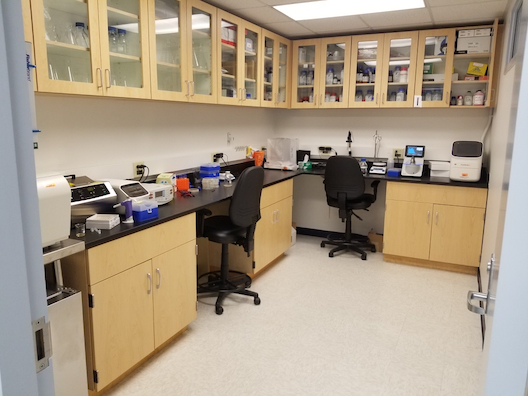 SYBORGS Lab
SYBORGS Lab

The mammalian half of the SYBORGS Lab is housed in individual and shared space in the 2020-built Herbert Wertheim Laboratory for Engineering Excellence, which is an 84,000 sq. ft. flagship edifice for the UF Herbert Wertheim College of Engineering resulting from a $300 million public-private partnership. This individual and shared space is on the fifth floor, in a state-of-the-art biotechnology lab for engineering solutions to overcome cancer, cardiovascular and muscular system disorders, and neurodegenerative diseases. This lab is compliant with BSL-2 biosafety guidelines. Within the shared space, we are allocated: a fume hood; three large sinks; a -80°C freezer; a -20°C freezer; a 4°C refrigerator; four lab benches that can simultaneously accommodate seven experimentalists and that are plumbed for air, water, gas, and vacuum; and two computational stations.
This allocation enables our coagulation research. Specialized coagulation equipment include: two TEG 5000 units (Haemonetics) to measure viscoelastic whole cell clotting; a Calibrated Automated Thrombogram (CAT, Stago) to measure thrombin concentration time-history after plasma sample stimulation by tissue factor; a Fluoroskan Ascent (Thermo Scientific) plate reader that pairs with the CAT; and an STA Compact Max SCE (Stago) to measure blood sample protein concentrations, prothrombin time (PT), partial thromboplastin time (PTT), etc. In the allocated space, we also have a Neon transfection system (Invitrogen), two Countess II Automated Cell Counters (Invitrogen), a centrifuge, standard lab equipment, and glassware. Shared equipment in the shared space include: BD FACS Melody BRV 9 and Cytek Northern Lights cytometers; a Keyence BZ-X microscope; a Licor Odyssey FC; a BioTek Synergy platereader; a Bruker NanoWizard 4 XP AFM (bio atomic force microscope, BioAFM); a Zeiss LSM 900/Zeiss LSM 980 (photon confocal microscope); a Zetasizer Nano S dynamic light scattering system for sub-micron particle and molecular size and molecular weight measurement; several rheometers; and an autoclave. A shared histology facility is equipped for histological slide preparation, staining, tissue fixation, microtome sectioning, and dissection.
We also have individual space for tissue culture (e.g., for A549 alveolar epithelial type II cells), in a 139 sq. ft. room that is equipped with two biological safety cabinets (Thermo Scientific), two Heracell VIOS 160i CO2 incubators (Thermo Scientific), an optical Eclipse Ts2 microscope (Nikon) to confirm tissue culture, a box rack storage cryogenic (nitrogen) sample storage tank (Thomas Scientific), and a large sink. In the lab's microscopy suite, our microscope is a Ti2-E Inverted Epifluorescence Microscope (Nikon) with a SOLA SE II 365 Light Engine, a Plan Fluor Phase Contrast DL 4x Objective; a Super Plan Fluor Phase Contrast ADM ELWD 20x Objective, a Super Plan Fluor Phase Contrast ADM ELWD 40x Objective, a Plan Apochromat Lambda 100x Oil Immersion Objective with DIC, a DS-Fi3 color camera (Nikon), and an ORCA-Flash4.0 V3 sCMOS cooled mono camera (Hamamatsu) with a V3 Firebird Camlink Board to enable 100fps capture at full resolution. This microscope is atop an optical table (Melles Griot).

The bacterial half of the SYBORGS Lab occupies 558 sq. ft. on the ground floor of the MAE-C building on the UF campus. This facility is compliant with BSL-2 biosafety guidelines. It consists of a central work space with three adjoining rooms: a room for microbial research, another room for data collection and computational analysis, and a third room for storing biological supplies. The central work space is outfitted with a biological safety cabinet (Thermo Scientific), a fume hood, a large sink, and is plumbed for air, water, gas, and vacuum. A second biological safety cabinet (Thermo Scientific) is in one of the adjoining rooms. The computational room is equipped with computers and a printer. Up to eight personnel (five experimentalists and three data analysts) can simultaneously conduct research at different workstations in the facility. The facility has a -80°C freezer, a -20°C freezer, a 4°C refrigerator, a centrifuge, an autoclave, standard lab equipment, and glassware. Specialized synthetic biology equipment include: a Synergy NEO2SM multi-mode microplate reader with absorbance, luminescence, fluorescence intensity, fluorescence polarization, and time-resolved fluorescence capabilities (BioTek); a QuantStudio 3 Real-Time PCR system (Applied Biosystems); a MiniAmp Plus thermal cycler (Applied Biosystems); a Heracell VIOS 160i CO2 incubator with shaker (Thermo Scientific); a Heratherm oven (Thermo Scientific); a spectrophotometer (Nanodrop); a Qubit 4 fluorometer (Invitrogen); a micropulser electroporator (Bio-Rad); and an Owl Horizontal (gel) Electrophoresis System (Thermo Scientific). The lab also has two Autoclavable Vessel Rotary Cell Culture Systems (Synthecon), each with four 10 mL high aspect rotating vessels, and a Random Positioning Machine (Yuri), for 3D cell culture and different levels of simulated microgravity.